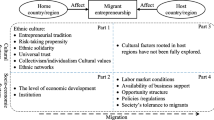Abstract
Because of an inflow of people into the EU but also because of the freedom of workplace choice within the EU, European regions are becoming more diverse in cultural terms. Despite the redistribution of labour and changes in regional labour supply, the ultimate question raised is whether there are additional gains or losses as a result of immigration flows. This paper therefore focuses on the impact of migrants on regional Gross Domestic Product per capita for European regions. Does the proportion of foreigners in the labour force increase or lower regional income? Does the composition of non-natives with respect to their countries of origin matter? We provide evidence that immigration and a higher degree of cultural diversity raise regional income, while controlling for endogeneity. We show that cultural diversity promotes income gains for destination countries. Whereas the presence of dominant groups reduces the costs of interaction and integration, diversity among foreign-born people increases the supply of different skills, knowledge and tasks. Thus, in general immigration has a positive net effect on regional performance and the costs of immigration in destination regions are balanced out. The regions of origin within the EU face a rise or a decline in income, depending on the labour market status of movers.



Similar content being viewed by others
Notes
School enrolment rates or the number of students in higher education are frequently applied to represent investment in new human capital.
In Table 5 we provide information, whether the data source for computing the investment rate is Cambridge Econometrics or Eurostat.
This is especially the case for Germany.
We still include respondents over the age of 65 who are active in the labour market.
The exception to this are the Baltic countries, where due to the Soviet history of these countries many Russians reside there.
The reference year for the dummy estimates is 2004.
The weight is computed as follows: \(w_{kr}=\exp \left( -\phi d_{kr}\right) ; \phi =-\ln\left[ \left( 1-\gamma \right) /D\right]\). The distance-decay parameter is γ = 0.5, which means that the proportion of migrants in the average neighbouring region (D = 167.24 km) enters with half of the original value. We standardize the weights so that the sum across all regions equals 1. In this case a weighted average of the proportion of migrants in all of the surrounding regions results.
We use the STATA xtivreg2 package, provided by Schaffer (2010).
With regard to immigration, the change in income is defined as \(dy/y=\beta \ast d\left( s_{migrants}^{r}\right),\) ceteris paribus.
References
Alesina A, Devleeschauwer A, Easterly W, Kurlat S, Wacziarg R (2003) Fractionalization. J Econ Growth 8(2):1–26
Alesina A, La Ferrara E (2004) Ethnic diversity and economics performance. NBER working paper no. 10313, February
Basile R, Girardi A, Mantuano M (2010) Interregional migration and unemployment dynamics: evidence from Italian provinces. Mimeo
Bellini E, Ottaviano GIP, Pinelli D, Prarolo G (2008) Cultural diversity and economic performance: evidence from European regions. HWWI research paper, 3–14
Brücker H, Jahn E (2011) Migration and wage-setting: reassessing the labor market effects of migration. Scand J Econ 113(2):286–317
Brunow S, Blien U (2011) Effects of cultural diversity on individual establishments. NORFACE discussion paper, no. 2011-6
Brunow S, Brenzel H (2011) The effect of a culturally diverse population on regional income in EU regions. WIFO working papers Wien, no. 413, pp 1–28
Brunow S, Hirte G (2006) Age structure and regional economic growth. Jahrbuch für Regionalwissenschaft 26:3–23
Caselli F, Esquivel G, Lefort F (1996) Reopening the convergence debate: a new look at cross-country growth empirics. J Econ Growth 1:363–389
Cheng S, Li H (2011) New firm formation facing cultural and racial diversity. Pap Reg Sci. doi:10.1111/j.1435-5957.2011.00404.x
Collier P (2001) Implication of ethnic diversity. Econ Policy 16(32):127–166
D’Amuri F, Ottaviano G, Peri G (2010) The labor market impact of immigration in Western Germany in the 1990s. Eur Econ Rev 54(4):550–570
Easterly W, Levine R (1997) Africa’s growth tragedy: policies and ethnic divisions. Quart J Econ 111(4):1203–1250
Etzo I (2011) The Determinants of the recent interregional migration flows in Italy: a panel data analysis. J Reg Sci 51:948–966
Fischer MM (2011) A spatial Mankiw–Romer–Weil model: theory and evidence. Ann Reg Sci 47:419–436
Islam N (1995) Growth empirics: a panel data approach. Q J Econ 110:1127–1170
Longhi S (2011) Impact of cultural diversity on wages and job satisfaction in England. ISER working paper series, no. 2011-19
Mankiw NG, Romer D, Weil DN (1992) A contribution to the empirics of economic growth. Q J Econ 107:407–437
Montalvo J, Reynal Querol M (2005) Ethnic diversity and economic development. J Dev Econ 76(2):293–323
Nathan M (2011) The long term impacts of migration in British cities: diversity, wages, employment and prices. MPRA paper 29465, University Library of Munich, Germany
Niebuhr A (2001) Convergence and the effects of spatial interaction. Jahrbuch für Regionalwissenschaft 21(2):113–133
Niebuhr A (2010) Migration and innovation: does cultural diversity matter for regional R&D activity? Pap Reg Sci 89(3):563–585
Ozgen C, Nijkamp P, Poot J (2011) Immigration and innovation in European regions. IZA discussion paper, no. 5676, April
Ozgen C, Nijkamp P, Poot J (2010) The effect of migration on income growth and convergence: meta-analytic evidence. Pap Reg Sci 89(3):537–562
Ottaviano GIP, Peri G (2005) Cities and cultures. J Urban Econ 58(2):304–337
Parrotta P, Pozzoli D, Pytlikova M (2010b) Does labour diversity affect firm productivity? ASB working paper, no. 10–12
Parrotta P, Pozzoli D, Pytlikova M (2011) The nexus between labor diversity and firm’s innovation. NORFACE discussion paper, no. 2011-5
Peri G, Sparber C (2009) Task specialization, immigration, and wages. Am Econ J Appl Econ 1(3):135–169
Ratna N, Grafton R, Kompas T (2009) Is Diversity bad for economic growth? Evidence from state-level data in the US. J Socio Econ 38(6):859–870
Schaffer ME (2010) xtivreg2: stata module to perform extended IV/2SLS, GMM and AC/HAC, LIML and k-class regression for panel data models. http://ideas.repec.org/c/boc/bocode/s456501.html
Sparber C (2010) Racial diversity and macroeconomic productivity across US states and cities. Reg Stud 44(1):71–85
Suedekum J, Wolf K, Blien U (2009) Cultural diversity and local labor markets. IZA discussion paper no. 4619, December, 1–33
Acknowledgments
This research is funded by the NORFACE research funding agency and part ofthe MIDI-REDIE sub-project, which we gratefully acknowledge. We would liketo thank two anonymous referees, Peter Huber (Wifo Vienna), the participantsof the 4th Wifo workshop in Vienna and the MIDI-REDIE workshop inTartu/Estonia for helpful comments and suggestions on earlier versions of this work.
Author information
Authors and Affiliations
Corresponding author
Appendix
Appendix
See Table 5.
Rights and permissions
About this article
Cite this article
Brunow, S., Brenzel, H. The effect of a culturally diverse labour supply on regional income in the EU. Empirica 39, 461–485 (2012). https://doi.org/10.1007/s10663-012-9201-z
Published:
Issue Date:
DOI: https://doi.org/10.1007/s10663-012-9201-z




